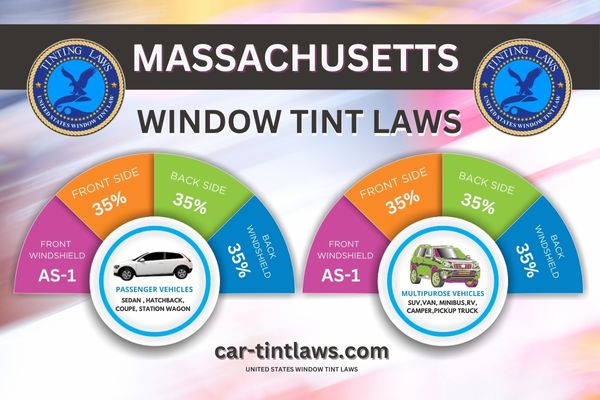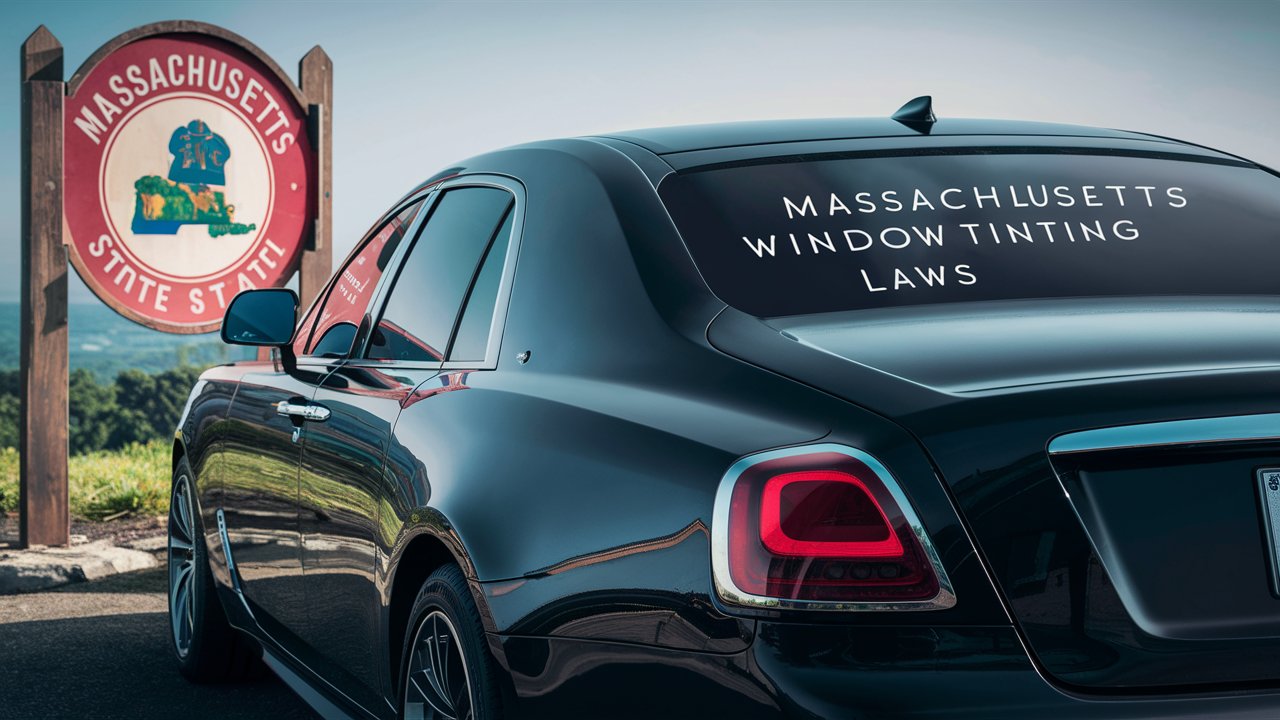When you’re considering tinting your vehicle’s windows in Massachusetts, it’s essential to understand the specific regulations to avoid hefty fines.
The state mandates that sedans have non-reflective tinting above the AS-1 line on windshields and that front, back, and rear windows must permit over 35% of light in.
SUVs and vans share these guidelines for side windows. Reflective tints cannot exceed 35% reflectivity, and rear window tints necessitate dual side mirrors.
Are you aware of the medical exemptions and the penalties for non-compliance?
Let’s explore how these rules might impact your vehicle modifications.
Window Tint Darkness in Massachusetts
When it comes to window tint darkness in Massachusetts, noting that sedans require more than 35% light transmission on all windows, including front, back, and rear windows, is crucial.
SUVs and vans adhere to the same rule, with a mandatory light transmission of more than 35% on all windows.
These regulations maintain a balance between privacy, sun protection, and visibility while driving.
Tint darkness for sedans:
- Windshield: Only a non-reflective tint above the AS-1 line is permissible.
- Front Side windows: Must allow more than 35% of light in.
- Back Side windows: Must allow more than 35% of light in.
- Rear Window: Must allow more than 35% of light in.
Tint darkness for SUV and Vans:
- Windshield: Only a non-reflective tint above the AS-1 line is permissible.
- Front Side windows: Must allow more than 35% of light in.
- Back Side windows: Must allow more than 35% of light in.
- Rear window: Must allow more than 35% of light in
Window Tint Reflection in Massachusetts
When considering window tint reflection in Massachusetts, understanding the limits for different vehicles is crucial.
For sedans, the tint reflection should not exceed 35% on both front and back side windows, ensuring compliance with state regulations.
SUVs and vans must also follow the same 35% reflectivity limit on front and back side windows, promoting safety and visibility on the road.
Tint reflection for sedans:
- Front Side windows: Must not be more than 35% reflective.
- Back Side windows: Must not be more than 35% reflective.
Tint reflection for SUV and vans:
- Front Side windows: Must not be more than 35% reflective.
- Back Side windows: Must not be more than 35% reflective.
Other Massachusetts window tint rules and regulations
- Side Mirrors: No restrictions.
- Restricted Colors: In Massachusetts all tint colors are permitted.
- Certificates: Manufacturers of film need to certify the film they sell in the state. Ask your dealer if they are using certified film.
- Stickers: The sticker/label of compliance to identify legal tinting is required between the film & glass on each tinted window.
- Medical Exceptions: Massachusetts permits medical exemptions for special tint. For more details about the specific terms of the exemption, consult MA state law.
- Penalties: Violating window tint regulations in Massachusetts could lead to fines. Maximum penalties include up to $250 for the first offense, up to $500 for the second offense, and up to $1,000 for subsequent offenses.

Medical Exemptions for Window Tint Rules in Massachusetts
If you have a medical condition that necessitates additional sun protection, Massachusetts permits medical exceptions to its window tinting laws.
These exceptions allow you to install darker window tints on your vehicle, guaranteeing you receive the essential protection without violating the law.
To be eligible for a medical exception, you require a letter from a licensed physician detailing your specific health considerations and why darker tints are essential for your condition.
Massachusetts tinting laws acknowledge that certain medical conditions necessitate special adjustments, such as extra sun protection or glare reduction.
By permitting medical exceptions, the state demonstrates a considerate approach towards the requirements of individuals with unique health considerations.
This adaptability ensures that while general safety regulations are upheld, those with valid medical needs can still feel at ease and safeguarded.
It’s crucial to remember that the medical exception process is designed to be simple but demands appropriate documentation from a healthcare professional.
Ensure you consult with your physician and acquire the necessary paperwork before requesting an exception.
This guarantees that your darker window tints are in compliance with the law and that you receive the protection you require.
Massachusetts Window Tint Ticket Cost
Violating Massachusetts window tinting regulations can lead to fines as high as $250.
If you’re caught breaking the law by having tint that’s too dark or reflective, you could face significant financial penalties.
Additionally, repeat offenses might even result in a suspension of your driver’s license, making it vital to comply with the state’s window tint laws.
In Massachusetts, it’s important to remember that side mirrors are required if your rear windows are tinted.
This ensures that drivers maintain proper visibility and safety on the road.
While manufacturers aren’t obligated to certify window tint film in Massachusetts, using a legal tint that meets the state’s standards is crucial to avoid trouble.
Although it’s not obligatory, it’s recommended to use stickers that indicate your tint complies with Massachusetts window tint laws.
These stickers can help you avoid misunderstandings and potential fines.
Keeping these regulations in mind will help you stay within the bounds of the law and avoid unnecessary penalties.
Massachusetts Vehicle Regulations Overview
In Massachusetts, there are specific regulations you must follow regarding window tinting on your vehicle, including limits on tint darkness and reflectivity.
The law mandates a minimum of 35% visible light transmission for side and rear windows, ensuring adequate visibility.
Additionally, front windshields can only be tinted up to the AS-1 line and must not be reflective to maintain safe driving conditions.
Tint Darkness Limits
When it comes to tint darkness limits in Massachusetts, your vehicle’s windows must allow more than 35% of light to pass through.
This means that the window tint darkness, or Visible Light Transmission (VLT) percentages, is regulated for safety and compliance.
For sedans, the front side windows, back side windows, and rear window all must adhere to this 35% light transmission rule.
Similarly, SUVs and vans also follow the same 35% VLT percentage for the front side windows, while the back side windows and rear windows can have darker tints but still need to follow state regulations.
Windshield tint is another area of concern. In Massachusetts, you can only use non-reflective tint on the top six inches of your windshield, often referred to as the AS-1 line.
This ensures that drivers maintain clear visibility while driving.
These rules are in place to balance aesthetic preferences with safety considerations.
Reflective limits are also defined, but we’ll discuss that in the next section.
By following these guidelines, you contribute to a safer driving environment for everyone on the road.
Reflectivity Restrictions
While tint darkness limits are important, reflectivity restrictions play an essential role in promoting safety on Massachusetts roads.
Massachusetts regulations limit window tint reflectivity to a maximum of 35% on both the front and back side windows for sedans, SUVs, and vans.
These rules are designed to prevent excessive glare, which can impair visibility and create hazardous driving conditions.
Adhering to the 35% reflectivity limit helps maintain clear visibility, allowing drivers to see their surroundings and react to potential hazards more effectively.
This focus on road safety is crucial, as it reduces the risk of accidents caused by glare from overly reflective windows.
When your vehicle’s window tint reflectivity stays within the legal limits, you’re contributing to a safer driving environment for everyone.
The regulations guarantee that all drivers can see clearly, day or night, regardless of lighting conditions.
By following these guidelines, you’re helping to promote road safety and protect yourself and others from potential harm.
Remember, these rules aren’t just about compliance; they’re about creating a safer community on Massachusetts roads.
Stick to the 35% reflectivity limit and support a safer, more visible driving experience for all.
Additional Tint Rules
Understanding Massachusetts’ vehicle tinting laws involves grasping a few additional rules beyond darkness and reflectivity limits.
For starters, if you decide to tint your rear window, you’ll need to confirm your vehicle has dual side mirrors.
This requirement helps maintain visibility, even with tinted windows, enhancing safety for all road users.
Additionally, while Massachusetts prohibits excessive reflectivity for glare reduction, it imposes no restrictions on tint colors, leaving you free to choose the shade that best suits your style.
Moreover, Massachusetts allows medical exemptions for individuals with specific conditions that benefit from reduced sunlight exposure.
If you have a medical condition that necessitates darker tints, you can apply for an exemption with certification from a physician.
This exemption permits you to exceed standard tinting limits, guaranteeing your comfort and safety while driving.
It’s essential to comply with these additional rules to avoid penalties and confirm your vehicle meets state regulations.
By understanding these specific requirements, you can make informed decisions about your vehicle’s tinting, ensuring both legal compliance and personal satisfaction.
Whether for aesthetic purposes or medical needs, adhering to these rules helps maintain a sense of community and shared responsibility on the road.
References
Frequently Asked Questions
Will I Get Pulled Over for 20 Tint in Massachusetts?
You’ll likely get pulled over for 20 tint due to low tint visibility. Police enforcement is strict, and you risk tint fines.
However, if you have tint exemptions for medical reasons, you’re safer. Prioritize tint safety!
What Is the Darkest Legal Tint in Massachusetts?
Curious about car tinting? The darkest legal tint percentage in Massachusetts is 35% VLT.
Stick to these legal limits for safety concerns. Consider the installation process and cost factors for a smooth, savvy tinting experience.
What Medical Conditions Qualify for Window Tint in Massachusetts?
You’re eligible for medical exemptions if you’ve got health conditions like photophobia or photosensitivity.
With a doctor’s note, you can exceed legal limits for window tinting, ensuring your tint requirements meet your medical needs.
Is 35% Tint Dark Enough?
Think of 35% tint like a perfect pair of sunglasses. It balances tint visibility, heat reduction, and UV protection while addressing privacy concerns and offering aesthetics appeal.
You’ll belong to a community of savvy, stylish drivers.
Conclusion
To sum up, understanding Massachusetts window tinting laws is essential for all vehicle owners.
One interesting statistic is that violations can lead to fines of up to $250, which underscores the importance of compliance.
Remember, sedans, SUVs, and vans must have non-reflective tints above the AS-1 line on windshields and allow more than 35% of light in on side and rear windows.
Additionally, rear window tinting mandates dual side mirrors, and medical exemptions are available with proper documentation.
